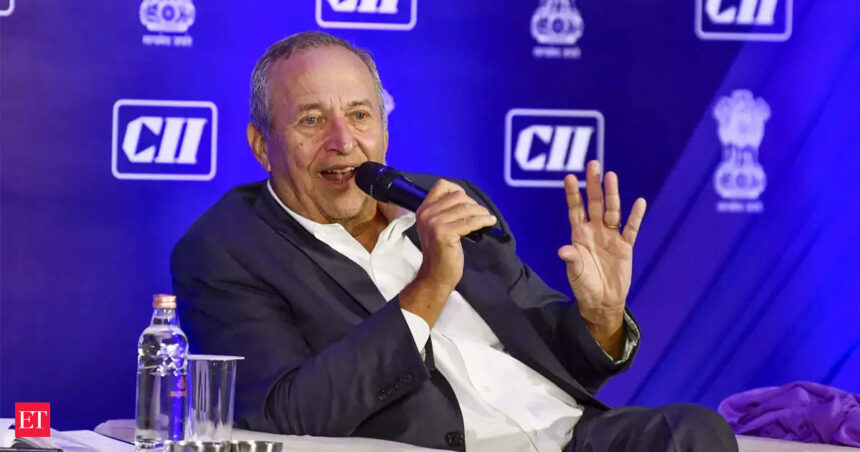The New Delhi declaration had a substantial focus on MDB reforms. Are you satisfied with the outcome?
It represents good progress, but only one step along the road. Ultimately, it’s not good intentions, it’s not even good plans, but it’s good implementation (that matters). I think the statement was a statement of good intentions and it was a start towards making plans, but ultimately making those plans concrete and implementing them is the work that is before us.The expert group would present the second volume next month. What will be its focus?
We look forward to its release in a few days. It will reiterate some of the key messages of the first part.
It will emphasise the need for discontinuity rather than continuity for transformational change in the MDBs. But it’s not enough. We will argue for the quantity of resources that they handle to be transformed, and the ways in which they do business need equally to be transformed. They need to focus on moving from projects to platforms, from public sector-led approaches to joint, public, and private approaches, and from being individual performers to functioning as a team with the multilateral banks cooperating together more strongly.
The recommendations given in both the volumes will need substantial reform in the way MDBs operate…
That’s correct. We need discontinuous change, not merely continuous evolution. That change must be both quantitative in the scale with which they operate and qualitative in the way in which they operate.
Are there low-hanging fruits in terms of the changes that can be taken up immediately?
The things that can be done most quickly are the adjustments in their financial engineering. We are prioritising financial risk over planetary risk in the way they do business now. There is no reason why, as any number of expert groups have recommended, the World Bank and the other multilateral development banks cannot stretch their existing balance sheet capacity further. The same is also true at the International Monetary Fund. We need to start by leveraging the resources they already have more effectively.
In their first statement to the recommendations, MDBs said these need to be assessed according to the capital structures, the mandates, and the shareholding of each MDB which varies across institutions. Do you think this could have an impact on the effectiveness of the implementation of the reforms suggested?
I think there’s no question that each region is different; each bank is different. But I think the broad principles here are universal and there will be differences in how they’re implemented in different institutions, but they need to be implemented more quickly.
The panel has also proposed an independent oversight for bringing about reforms at the MDBs. How will this help in the effectiveness of the reform?
More transparency, more reporting, and more accountability is good for any institution. Often public sector institutions are not subject to the kind of accountability that earnings reports quarterly impose on private institutions. The right metrics for public institutions are different from the right metrics for private institutions, but that does not mean that transparency, review, and oversight are not terribly important, and the proposal for a panel of review is directed in assuring that kind of transparency, review, and oversight.
One of the key issues is whether the financial commitment needed as part of the reform will come from the shareholders….
I am guardedly optimistic. I know that (US) President (Joe) Biden and his team are very focused on the importance of global public good, on the importance of doing more and I think what the United States does often has a very substantial influence. So, I don’t minimise the challenge in a moment when there are big deficit issues in many countries, and when too many countries are perhaps turning inwards, but I am hopeful that given the tremendous capacity of even small sums of money when appropriate, that very good things can happen.
The debt resolution framework has been criticised. Can the G20 push ensure an expeditious solution in addressing the situation, including bilateral debt distress?
I hope so. I’m not sure what will actually materialise. I think a great deal will depend upon the way in which Chinese creditors and other creditors are prepared to engage going forward. Ultimately, I would rather focus on the flow of resources to countries.
US Fed has opted for a pause but markets expect another rate hike. What would this ‘higher for longer’ mean for emerging economies like India?
Other things equal, a world of lower interest rates is a more comfortable world. But failure to control inflation would have the most catastrophic consequences because it would lead to a major economic downturn. So, I think the Fed’s posture of vigilance with respect to inflation is appropriate given what appears right now to be the strength of the American economy, though that could easily change.
Post-pandemic, we’ve seen geopolitics and protectionism have impacted free trade and globalisation consensus which existed for very long. What kind of consequences could this have for the global economy, and how should it be dealt with?
I think the world is likely to flourish together or to suffer together. It is not easy to imagine scenarios in which some parts of the world flourish and other parts do not. A divided world may be a world of limited cooperation on crucial issues like climate and pandemic.
You’ve been visiting India for the past 32 years. How do you see the Indian economy, especially considering the goal that Prime Minister Narendra Modi has set about it becoming a developed nation by 2047.
I am very optimistic about India’s prospects. Abundant labour still at low cost, the rule of law… great facility with information technology, increasing openness to the world, and an extraordinary diaspora that represents a tremendous national asset. I am hopeful that India’s economy will grow by as much as eightfold by mid-century.







